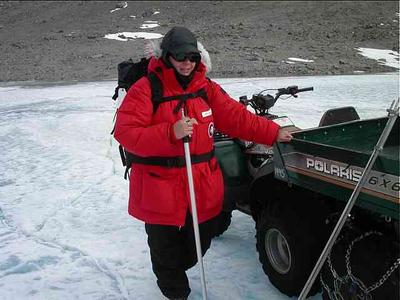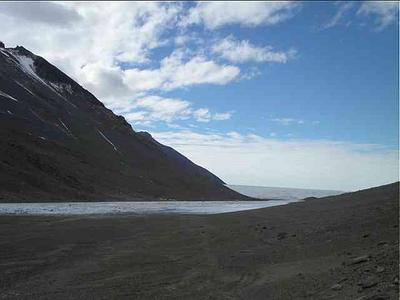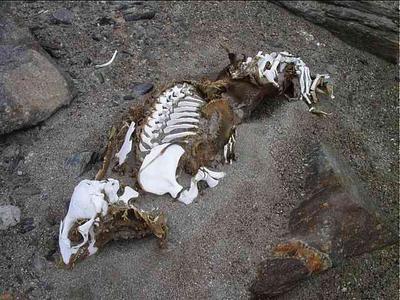30 December, 2002
Surveying and Sampling
My mettle was tested today! Jen and I did our first lone hike to
two of the streams. First we loaded our gear into the ATV, or
All-Terrain-Vehicle, to drive it west to the end of Lake Hoare. We
found out before even getting to the machine why we should always
wear our ice grippers when walking on lake surfaces. Jen took a
rather graceful, but nasty, fall on the slick ice just before
reaching the rough edge of the permanent ice. Luckily she was not
hurt badly, but it shook us both up to realize how quickly accidents
can happen.
At the end of Lake Hoare, we parked on the permanent ice and
walked across the slick young ice near the shore. Then we headed
overland, climbing small hills, traversing uneven rocky surfaces, and
sinking inches into soft, deep sand. The walk itself was interesting
with beautiful scenery and not all that long or difficult. BUT, then
strap on a fifty pound backpack and carry a fifteen pound tripod,
wear twenty pounds of clothing, and all of a sudden your back and
shoulders are tested to the max.
You are so alone out here that it is easy to imagine you have been
dropped off on an alien planet. The only signs of life were a lone
skua and three helicopters with sling loads that were being dropped
off in different camps in Taylor Valley. Do you remember that a
sling load is a heavy load tied under the helo on a long rope? It
swings freely as the helo flies, and it is kind of a strange sight to
see.
Even though there were not many signs of life, there were lots of
signs of death, and reminders that Antarctica can be harsh and
unforgiving of mistakes. We passed at least eight mummified seals or
skeletons. You can not help but wonder how they got so far inland
and why they came. It was a mistake that cost them their lives.
I am camped in the Taylor Valley of the Dry Valley system of
Antarctica. Most of Antarctica, 98 per cent, is covered by snow and
ice, but 2 percent has not had much, if any, precipitation in
millions of years. It looks like I imagine Mars would look, BUT,
there are glaciers that reach their long frozen fingers in through
the mountains which surround the valley. In the summer, which of
course is now, the edges melt and send streams flowing through the
valley, feeding the four frozen lakes. There is not much life here--a
little algae and moss and some microscopic worms and bacteria.
Jenā¤s and my job, along with Erin when she arrives, is to
re-survey the streams. We were trained in McMurdo on how to use the
surveying equipment. You may have seen surveyors working near your
home. One person sets up the Total Station, our surveying
instrument, at a known elevation. It has to be carefully balanced and
leveled which takes some time to do. Then the surveyor measures the
distance to the other partner who is holding a rod on another known
elevation, called the backsight. After that measurement is entered
into the machine, we take measurements up and down the streambeds,
where the water is running; the wetted zones, where you can see wet
ground; the snow edge, if there is one; and through the thalwig, or
deepest portion of the stream.
When the Total Station first turns on, the word Theo comes on the
screen. We now fondly call it by first name, Theo! I'm the "rod-man"
with the survey equipment. I walk up and down the streams, deciding
where the rod should be placed to make the best topographic map of
the stream. Jen records each measurement that she takes after making
an infrared sighting through Theo directed at the prism on top of my
rod. I have had to develop skill in recognizing the different parts
of the stream. It requires a lot of walking, but it is good
exercise, and since I am moving, I do not get cold very often. My
waterproof boots are letting water in, so when I take my thalwig
measurements my feet are getting wet. That has been pretty miserable!
I plan on talking to the company who sold these to me. If they do not
make them good when I get home, I will let you know which brand NOT
to buy! Theo takes about an hour and a half to do the whole stream.
We then take algae samples and must also survey the exact location
where the samples were taken. We take four samples from each spot.
Three are put into bags, and one is placed in a bottle. All will be
analyzed later. I will explain that process in another journal.
Then we do a pebble count. Randomly, without looking, you reach
down and pick up a pebble. You measure the long side and the short
side and then put it back. We do this one hundred times to get an
average of pebble size in the stream. This is called the Wolman
Pebble Count. You can imagine that this has quickly become my least
favorite job! It does not take long for your hands to start
freezing, and your back begins hurting from leaning over. Jen and I
are trying different ways to divide the task. One of us records,
while the other samples. We tried switching after twenty pebbles, so
the picker- upper can warm her hands. Today Jen felt it was not as
cold, so she did all one hundred while I recorded. She was fast!
Guess it will have to be my turn tomorrow. And now the challenge is
on to see who can do it the fastest!
Another job at each stream is to take water samples, conductivity
readings which measure ions in saturation, pH and temperature
readings, and a flow measurement. All of these jobs are new to me,
so I am learning as we go. Jen has been a patient teacher and I am
trying to be a quick and careful studentā¤"a new role for the
teacher!
There were a few frustrations today. We hiked to House Creek, but
after a careful scouring, we could not find our two elevation marks.
Without those we could not do the work we were sent to do. At one
point I was actually rock climbing the face of one of the steep
slopes looking for the mark. It reminded me of working out back at
Kennedy Junior High School where Mr. Scarpino was having me climb our
school wall blindfolded, training me for this trip. Thanks, Tony.
Except for the blindfold, it was a skill I really needed. Luckily I
did not fallā¤"there were no mats under me this time!
We left House Creek feeling a little defeated, but knowing that
this is science. Often when you are in the field, things do not go
according to your plan. You adjust and make the best of the
situation. Soā¤|we hiked around Lake Chad to the south side of Seuss
Glacier where we found Wharton Creek. Those backpacks were feeling
really heavy by this part of the trip. But we had a good day, and
finished almost all of the measurements we needed to make. Tomorrow
we can make a quick trip without most of our gear and finish quickly.
By this time we were cold, tired and hungry, but we still had to
walk back to the ATV carrying all of our gear. That was truly the
longest, most grueling hike I have ever taken. My back, shoulders,
and legs were aching, but when we arrived back at Lake Hoare, Thomas
Nylen, the glaciologist, and Leslie Blank, the assistant camp
manager, had made a wonderful Thai shrimp meal for us and suddenly
everything was positive again! The aches are still there, but I am no
longer hungry and cold.
My grandfather McNeill was a surveyor in Florida many years ago.
He was also always full of adventure. I think every once in awhile
that he is looking down at me and smiling that a granddaughter of his
would be doing such a thing in this wild and wonderful place!

1. Me dressed for a day of science - - what a load
to carry across rough terrain!

2. Jen next to the ATV.

3. Looking from the Seuss Glacier at Wharton Creek,
down the valley toward Canada Glacier, the one outside my tent at
Lake Hoare.

4. Skeleton of a seal - - sad reality is that this
is a harsh environment.

5. Seuss Glacier - - the dark spot is actually a
water fall that is flowing into the origin of Wharton Creek.
Contact the TEA in the field at
.
If you cannot connect through your browser, copy the
TEA's e-mail address in the "To:" line of
your favorite e-mail package.
|
